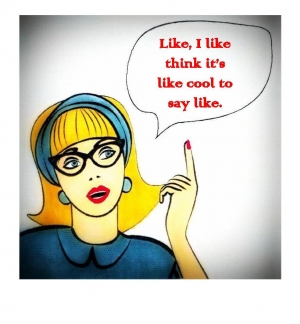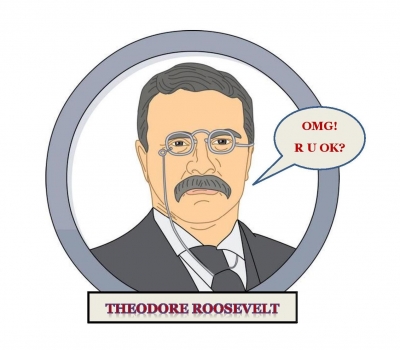The “like” virus going around may not have infected you yet. If you are over 50 you’re probably immune. How can you tell if you’ve got it? Simply count the number of times you use the word like in a sentence. Here are some examples:
The school is like only five blocks from my house.
They like love you!
I have like no clue.
What’ll be like your major?
What’s like wrong with your sister?
Just be like quiet.
I like don’t care.
I didn’t go anywhere like.
Sound familiar? Peppering one’s speech with like has become epidemic in America. It’s been growing since the 1950s. Linguists think that a television character named Maynard G. Krebs on the Dobie Gillis series (1959-1963) popularized the use of like. The Krebs character did not invent the like virus, but he exposed millions of viewers to it. The use of like died down for a few decades, then caught fire again in the 1980s when the stereotype Valley Girl was celebrated in pop culture. The spread of like was also fueled by the TV character Shaggy on the cartoon series Scooby Doo. Shaggy’s personality and speech were inspired by the Maynard G. Krebs character. The like virus has proven to be enduring and powerful because it is versatile.
- Like can function as a filler similar to “you know,” uh, er, and um. Examples:
My math teacher, like, told me, like, the pop quiz wouldn’t, like, hurt my 6-week’s grade, because he used this, like, formula to, like, curve my average.
- Like can function as a filler similar to “you know,” uh, er, and um. Examples:
My math teacher, like, told me, like, the pop quiz wouldn’t, like, hurt my 6-week’s grade, because he used this, like, formula to, like, curve my average.
- Like can also be used to replace standard words such as “say” or “think.” Examples:
She was like, “Don’t wait for me.” He was like, “Okay, I guess so.” They were like, “You’re acting immature.”
- Like can be used to approximate a quantity or shade of meaning. Examples:
There were like 100 people in the store. Like 3,000 live here.
- Like can be used to introduce gestures and unspoken ideas and sentiments. Examples:
He was like (speaker shrugs shoulders). We were all like (speaker rolls eyes). I like (speaker nods head “yes”), and she was like (speaker moves head from side to side “no”), so now we’re (speaker waves hand in dismissal).
- Like can be used as punctuation to signal the end of a sentence. Examples:
We don’t want to go to grandma’s, like. Batman is not my favorite super hero, like.
The strange thing about the like virus is that it is strictly verbal. It doesn’t show up in formal writing. Teenagers use some forms of the like pattern in texting, but when word count is at stake, they omit the like, opting for wow instead of Like wow.
There’s no linguistic vaccine or cure for the like virus, but some activities succeed in stamping it out. Learning to speak, read, and write in a foreign language drastically improves one’s ability to be precise and articulate in speech and writing. The practice of writing also improves thinking, logic and speech.
If you are like virus-free, you can be proud that you did not pick up a speech pattern that makes one sound less than articulate and intelligent. If you used to have the like virus and now you don’t, be reassured that as we get older we sound smarter!
The answer is “no one.” Unlike Chinese, Spanish, French, and other languages, English has never been regulated by an academy of experts who decide whether new words and phrases should be admitted to the language. English is a dynamic, free-wheeling, constantly changing language.
An American president once tried to police the English language. In 1906 President Theodore Roosevelt issued an executive order that created the Simplified Spelling Board. The executive order listed 300 words that would be spelled differently in all government publications. Some of the words simplified British spellings. Ardour became ardor, arbour became arbor and clamour to clamor. Purr was changed to pur – no need for that double r. (Also makes you wonder why the word purr appeared in a government document) Other words were spelled phonetically. Blessed became blest, kissed became kist, though became tho, and through became thru. Seems like Roosevelt was way ahead of his time. Many of his spelling reforms are now the language of millions on social media.
Roosevelt’s executive order was met with laughter and outrage. Newspapers made fun of Teddy’s spelling. The Louisville Courier-Journal published an editorial written entirely in phonetic spelling, saying of Roosevelt, “No subject is tu hi fr him to takl, nor tu lo for him tu notis.” Both Congress and the Supreme Court refused to follow Teddy’s spelling rules. Roosevelt was accused of being a dictator, and of trying to set up some sort of French academy. Roosevelt issued the executive order on August 27, 1906. Due to public outrage and ridicule by newspapers, Roosevelt withdrew the executive order three months later on December 13, 1906 when the House of Representatives passed a resolution saying all government documents would follow spelling rules in dictionaries.
Who has the power to change English today? Several associations issue guidelines and monitor usage. Dictionaries try to keep up with changing definitions and new words, and slang dictionaries abound online. Social media recently responded to a celebrity’s request for change. Twitter isn’t the Merriam-Webster Dictionary or the Modern Language Association, but it wields pop culture influence when it comes to contemporary spelling and usage of English. The celebrity is Kim Kardashian West. The source of her power is 33.8 million Twitter followers. Kim simply asked Twitter for help with her misspelled words. She suggested that Twitter add an editing function so when she misspelled a word, she wouldn’t have to delete her tweet and start over. “Great idea,” responded Twitter. Presumably they are adding the feature soon. Presumably Kim sent Twitter a big “thk u.”



